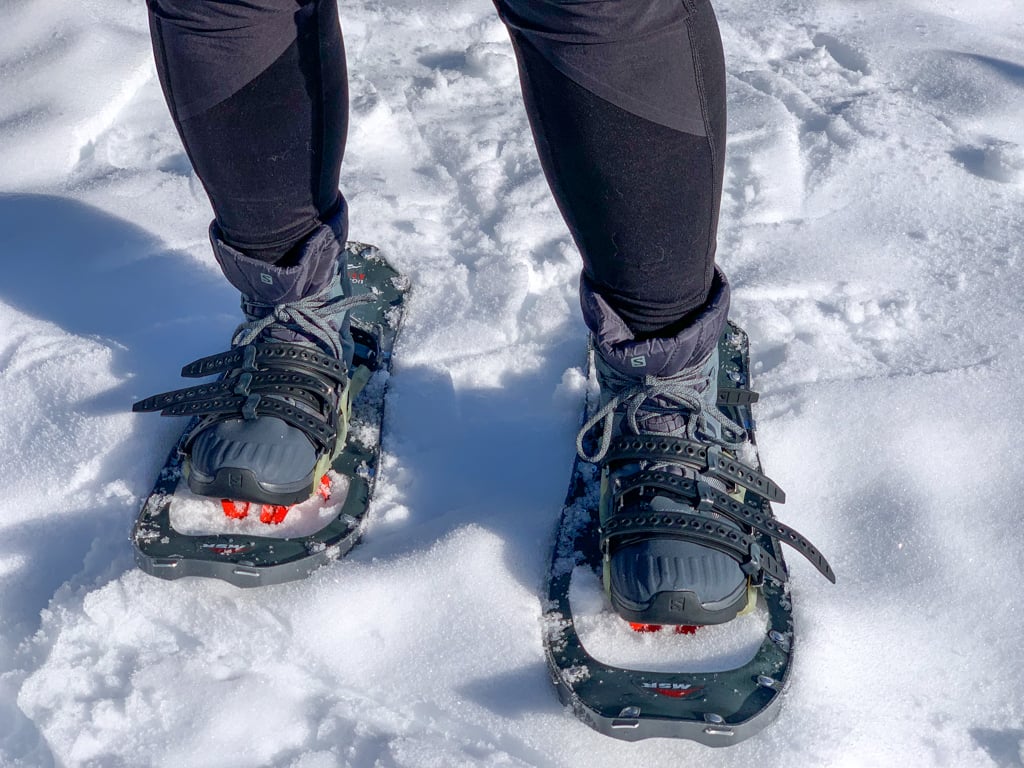
This means the moisture from your feet can easily escape without letting. Hiking boots can be the best option for snowshoeing as long as they are insulated and warm.

Snowshoes will keep you above the snow but because you still may end up stepping into deep snows you generally want to wear some kind of insulated waterproof winter hiking boots in your snowshoes.
Good boots to wear with snowshoes. In case you decide to wear running shoes hiking boots or any other non-insulated footwear purchase and wrap a pair of neoprene cover around the boot for additional warmth lest risk having cold feet. Snowshoe bindings should have a secure and tight fit for a fun and comfortable adventure. Cinching the bidding heel straps tightly help achieve this but it also exerts significant pressure on the upper part of your footwear.
Therefore if the top of your boot. You want to wear boots that cradle your feet and arent too soft. Otherwise your bindings will squish your toes which can be really uncomfortable.
Hiking boots and insulated winter hiking boots offer great support for your ankles and cradle your feet better than traditional floppy winter boots. Snowboarding boots are also ideal for snowshoeing. Wool socks for hiking andor a woolsilk combination for running are important to snowshoeing.
And if you plan to snowshoe in deep snow and dont plan to stay on snow-packed trails wear Gaiters to keep snow out of your boots and shoes. What do you wear snowshoeing in Vancouver. Footwear with a Gore-Tex lining or its equivalent work well as do winter boots with waterproof rubber around the lower half of the boot.
If you choose to snowshoe in mid or low cut hiking boots make sure to wear gaiters over your boot so you dont get snow in your shoes while snowshoeing. The traction underneath the shoe is also a matter of preference. While on your outings the snowshoe not your boot or shoe provides traction.
For this reason in addition to winter boots you can use light hiking boots Canadian leather moccasins or old running shoes for your snowshoe boots. If you would wear those boots in the snow anyway then there is a good chance the boots can be worn with snowshoes. Regular winter boots may be stiff heavy and dont breathe well.
If you are going to be going out for a long walk then these may not be the best solution. Snowshoes and Hiking Boots. Hiking boots can be the best option for snowshoeing as long as they are insulated and warm.
Since they dont have any insulation the Timberland Ledge boots are not the best option for dedicated snowshoers but can be a good pair of boots to have if you infrequently find yourself in snowy conditions. Durable waterproof leather upper. Seam-sealed construction for extra waterproofing.
Sturdy rubber outsole for high traction. When you use snowshoes the only way to really use them to their fullest potential is by accompanying them with a good pair of hiking boots. Otherwise the snowshoes really wont do much for you.
Of course hiking boots are also good to have because they give you options. Like you can use crampons instead of snowshoes in certain conditions. Other snow boots can be worn as a fashion statement particularly for women even when it is not snowing.
Boots such as the Sorel Conquest Carly and The North face Shellista II are considered trendy and stylish. And are increasingly being worn for more than just traction in the snow. Up Next In Winter Sports.
How To Get in Shape for Snowshoeing. So your main concern is to wear something that keeps your feet comfortably warm and dry. Insulated waterproof winter boots with thick soles and rubber or leather uppers are ideal but sturdy waterproof leather hiking boots can also work.
Wool or synthetic socks that wick sweat are a mustcarry an extra pair in case yours get soaked. In addition they are really good out in the elements. For example the boots actually provide good traction because of their innovative G3 LOWA outsole both on ice and snow.
The boots also have a Partalena fleece lining that provides extra warmth. The boots are also waterproof without sacrificing breathability. This means the moisture from your feet can easily escape without letting.
They are warm durable and can grip ice a lot better than regular boots. They still need microspikes all hiking boots do but it still does better on ice than most boots. These are probably some of the best boots for snowshoeing.
Buy My Fav Snowshoe Boots Here Oboz Bridger Insulated Boots. Snowshoes will keep you above the snow but because you still may end up stepping into deep snows you generally want to wear some kind of insulated waterproof winter hiking boots in your snowshoes. The aggressive tread of hiking boots will also help keep your feet.